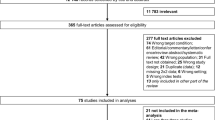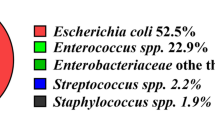Abstract
Purpose
The aims were to assess (1) the diagnostic value of serum procalcitonin (PCT) for acute pyelonephritis (APN) in infants and children with urinary tract infections (UTIs) and (2) to compare the performance of two commonly used cutoff values.
Methods
A meta-analysis of serum PCT in the diagnosis of APN among pediatrics with lower UTIs was conducted. The process of search strategy, publications selection and data analysis was in accordance with the preferred reporting items for systematic reviews and meta-analyses guidelines.
Results
Eighteen high-quality studies with a total of 831 APN patients and 651 individuals with lower UTIs were analyzed. The overall performance of serum PCT ≥ 0.5 ng/mL was as follows: pooled sensitivity of 0.86 (95 % CI 0.73–0.93), pooled specificity of 0.76 (95 % CI 0.66–0.83), DOR of 18.90 (95 % CI 6.78–52.71) and AUROC of 0.86 (95 % CI 0.83–0.89), with significant heterogeneity. However, use of 1.0 ng/mL as a cutoff value produced an improved specificity of 0.91 (95 % CI 0.86–0.94), a DOR of 55.06 (95 % CI 22.57–115.48) and an AUROC of 0.94 (95 % CI 0.92–0.96), without obvious heterogeneity.
Conclusion
In pediatrics with UTIs, the cutoff value of serum PCT, 1.0 ng/mL, has a preferable diagnostic performance compared with 0.5 ng/mL for APN. Additional prospective studies that propose an appropriate cutoff value and validate the performance of PCT for young with APN are needed in the future.




Similar content being viewed by others
References
Marild S, Jodal U (1998) Incidence rate of first-time symptomatic urinary tract infection in children under 6 years of age. Acta Paediatr 87:549–552
Montini G, Tullus K, Hewitt I (2011) Febrile urinary tract infections in children. N Engl J Med 365:239–250
Ghasemi K, Montazeri S, Pashazadeh AM et al (2013) Correlation of DMSA scan with radiological and laboratory examinations in childhood acute pyelonephritis: a time-series study. Int Urol Nephrol 45:925–932
Finnell SM, Carroll AE, Downs SM et al (2011) Technical report-Diagnosis and management of an initial UTI in febrile infants and young children. Pediatrics 128:e749–e770
Nahar A, Akom M, Hanes D et al (2004) Pyelonephritis and acute renal failure. Am J Med Sci 328:121–123
Mohkam M, Maham S, Rahmani A et al (2010) Technetium Tc 99 m dimercaptosuccinic acid renal scintigraphy in children with acute pyelonephritis: correlation with other imaging tests. Iran J Kidney Dis 4:297–301
Sheu JN, Chen MC, Lue KH et al (2006) Serum and urine levels of interleukin-6 and interleukin-8 in children with acute pyelonephritis. Cytokine 36:276–282
Sheu JN, Chen SM, Meng MH et al (2009) The role of serum and urine interleukin-8 on acute pyelonephritis and subsequent renal scarring in children. Pediatr Infect Dis J 28:885–890
Parenti GC, Passari A (2001) Acute pyelonephritis.Role of diagnostic imaging. Radiol Med 101:251–254
Lavocat MP, Granjon D, Allard D et al (1997) Imaging of pyelonephritis. Pediatr Radiol 27:159–165
Assicot M, Gendrel D, Carsin H et al (1993) High serum procalcitonin concentrations in patients with sepsis and infection. Lancet 341:515–518
Kotoula A, Gardikis S, Tsalkidis A et al (2009) Comparative efficacies of procalcitonin and conventional inflammatory markers for prediction of renal parenchymal inflammation in pediatric first urinary tract infection. Urology 73:782–786
Prat C, Dominguez J, Rodrigo C et al (2003) Elevated serum procalcitonin values correlate with renal scarring in children with urinary tract infection. Pediatr Infect Dis J 22:438–442
Belhadj JH, Coulais Y, Tafani M et al (2008) Procalcitonin implication in renal cell apoptosis induced by acute pyelonephritis in children. Infect Drug Resist 1:17–20
Smolkin V, Koren A, Raz R et al (2002) Procalcitonin as a marker of acute pyelonephritis in infants and children. Pediatr Nephrol 17:409–412
Gurgoze MK, Akarsu S, Yilmaz E et al (2005) Proinflammatory cytokines and procalcitonin in children with acute pyelonephritis. Pediatr Nephrol 20:1445–1448
Nikfar R, Khotaee G, Ataee N et al (2010) Usefulness of procalcitonin rapid test for the diagnosis of acute pyelonephritis in children in the emergency department. Pediatr Int 52:196–198
Sheu JN, Chang HM, Chen SM et al (2011) The role of procalcitonin for acute pyelonephritis and subsequent renal scarring in infants and young children. J Urol 186:2002–2008
Chen SM, Chang HM, Hung TW et al (2013) Diagnostic performance of procalcitonin for hospitalised children with acute pyelonephritis presenting to the paediatric emergency department. Emerg Med J 30:406–410
Zhang L, Yu Q, Guo KP et al (2013) Role of procalcitonin in the diagnosis of acute pyelonephritis in children. Chin J Contemp Pediatri 15:85–87
Mahyar A, Ayazi P, Ahmadi R et al (2014) Are serum procalcitonin and interleukin-1 beta suitable markers for diagnosis of acute pyelonephritis in children? Prague Med Rep 115:16–23
Mantadakis E, Plessa E, Vouloumanou EK et al (2009) Serum procalcitonin for prediction of renal parenchymal involvement in children with urinary tract infections: a meta-analysis of prospective clinical studies. J Pediatr 155:875–881
Leroy SL, Fernandez LA, Nikfar R et al (2013) Association of procalcitonin with acute pyelonephritis and renal scars in pediatric UTI. Pediatrics 131:870–879
Moher D, Liberati A, Tetzlaff J et al (2009) Preferred reporting items for systematic reviews and meta-analyses: the PRISMA statement. J Clin Epidemiol 62:1006–1012
Whiting P, Rutjes AW, Reitsma JB et al (2003) The development of QUADAS: a tool for the quality assessment of studies of diagnostic accuracy included in systematic reviews. BMC Med Res Methodol 3:25
Reitsma JB, Glas AS, Rutjes AW et al (2005) Bivariate analysis of sensitivity and specificity produces informative summary measures in diagnostic reviews. J Clin Epidemiol 58:982–990
Deeks JJ, Macaskill P, Irwig L (2005) The performance of tests of publication bias and other sample size effects in systematic reviews of diagnostic test accuracy was assessed. J Clin Epidemiol 58:882–893
Benador N, Siegrist CA, Gendrel D et al (1998) Procalcitonin is a marker of severity of renal lesions in pyelonephritis. Pediatrics 102:1422–1425
Gervaix A, Galetto LA, Gueron T et al (2001) Usefulness of procalcitonin and C-reactive protein rapid tests for the management of children with urinary tract infection. Pediatr Infect Dis J 20:507–511
Pecile P, Miorin E, Romanello C et al (2004) Procalcitonin: a marker of severity of acute pyelonephritis among children. Pediatrics 114:e249–e254
Tuerlinckx D, Vander BT, Glupczynski Y et al (2005) Is procalcitonin a good marker of renal lesion in febrile urinary tract infection? Eur J Pediatr 164:651–652
Bigot S, Leblond P, Foucher C et al (2005) Usefulness of procalcitonin for the diagnosis of acute pyelonephritis in children. Arch Pediatr 12:1075–1080
Guven AG, Kazdal HZ, Koyun M et al (2006) Accurate diagnosis of acute pyelonephritis: how helpful is procalcitonin? Nucl Med Commun 27:715–721
Karavanaki K, Haliotis AF, Sourani M et al (2007) DMSA Scintigraphy in Febrile Urinary Tract Infections Could Be Omitted in Children With Low Procalcitonin Levels. Infect Dis Clin Pract 15:377–381
Kotoula A, Gardikis S, Tsalkidis A et al (2009) Procalcitonin for the early prediction of renal parenchymal involvement in children with UTI: preliminary results. Int Urol Nephrol 41:393–399
Sun HL, Wu KH, Chen SM et al (2013) Role of procalcitonin in predicting dilating vesicoureteral reflux in young children hospitalized with a first febrile urinary tract infection. Pediatr Infect Dis J 32:e348–e354
Bouguila J, Khalef I, Charfeddine B et al (2013) Comparative study of C-reactive protein and procalcitonin in the severity diagnosis of pyelonephritis in children. Pathol Biol (Paris) 61:93–98
Xu RY, Liu HW, Liu JL et al (2014) Procalcitonin and C-reactive protein in urinary tract infection diagnosis. BMC Urol 14:45–49
Author information
Authors and Affiliations
Corresponding author
Ethics declarations
Conflict of interest
No conflict of interest was declared.
Ethical statement
The manuscript does not contain original clinical studies.
Electronic supplementary material
Below is the link to the electronic supplementary material.
Fig. S1
Methodological quality graph. Reviewer judgment of methodological quality of each individual study included in the analysis, according to the Quality Assessment of Studies of Diagnostic Accuracy included in Systematic Review (QUADAS) tool (TIFF 323 kb)
Fig. S2
Deeks’ plots for included studies. (A) Derived from studies using cutoff value of 0.5 ng/mL. (B) Derived from studies using cutoff value of 1.0 ng/mL. Linear regression of log odds ratios on inverse root of effective sample sizes as a test for funnel plot asymmetry in diagnostic meta-analysis. A nonzero slope coefficient is suggestive of significant small study bias (p < 0.10) (TIFF 904 kb)
Rights and permissions
About this article
Cite this article
Zhang, H., Yang, J., Lin, L. et al. Diagnostic value of serum procalcitonin for acute pyelonephritis in infants and children with urinary tract infections: an updated meta-analysis. World J Urol 34, 431–441 (2016). https://doi.org/10.1007/s00345-015-1630-4
Received:
Accepted:
Published:
Issue Date:
DOI: https://doi.org/10.1007/s00345-015-1630-4




